How To Rank Your Plastic Surgery Website 1st on Google, Guaranteed
How to get your Plastic Surgery Center’s Website to #1 on Google?
With perfect SEO, you can rank your plastic surgery website to the top of the google and get maximum surgery leads without wasting money on ads.
Published on May 30, 2024

What’s the best marketing strategy for a plastic surgery center to get more surgery leads and consultations in 2024? Depends who you’re asking.
Plastic surgery centers are investing heavily in digital marketing.
From website to search, social media to ads, plastic surgeons are doing them all. But are all these equally effective
Not quite.
From my professional experience of helping plastic surgery centers get surgery leads and consultations, there’s only one strategy that trumps all other strategies.
Organic search marketing.
There’s nothing like being on the top of the google search results when a potential patients do a google search. I know this because I have helped many plastic surgery centers get surgery leads and consultations through organic search.
How’d I rank a plastic surgery website 1st in google. We’ll discuss this today. Keep reading this article to see how SEO is the best strategy to get more surgery leads for your center.
Why SEO vs other marketing strategies?
First, let’s look at why other marketing strategies are a waste of money (and time) for plastic surgery centers.
Google Paid Ads is expensive
In case you’re new to this, google (PPC) paid search ads works like this…
Someone enters to keyword to search for a local plastic surgery center, and google search results appear with paid ads at the top of the page.
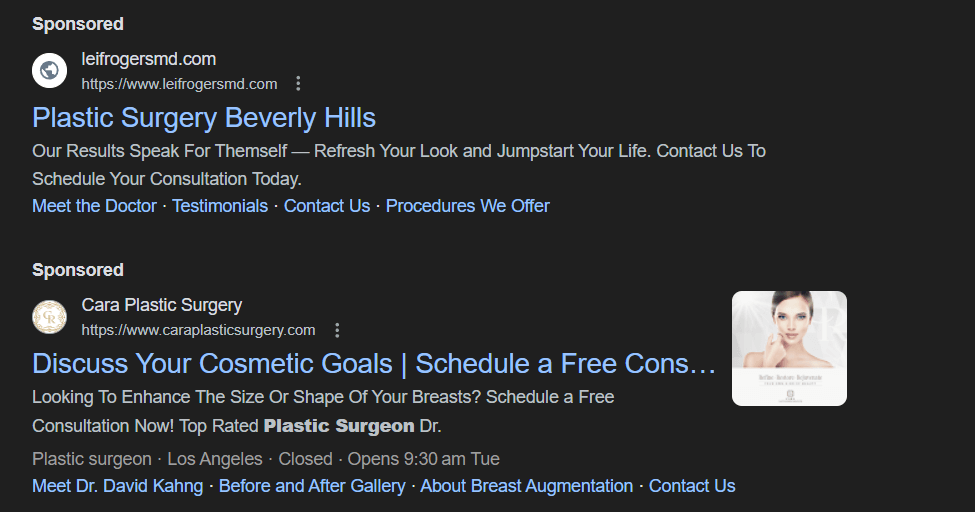
PPC means Pay-Per-Click. Whenever someone clicks on your paid ad, you pay $X (it depends on the competition for the keyword). For example, if you’re targeting plastic surgeon in new York city its $10.89/click, you’ll spend hundreds or even thousands monthly for surgery leads.
But is it worth it?
Yes and no. if you are doing it the right way…then yes.
And if you are doing it and not generating leads and consultations then absolutely not.
With the competition in the market, google ads are getting expensive day by day. So its good to have other options that doesn’t cost as much.
Social media ads have low conversion rate
Instagram, facebook, tiktok, all have ads algorithms. Social media feels like an obvious channel to marketing your special offers and surgery center because there’s tons of social media users.
But there’s a caveat: social media users are on the platform to socialize and engage. Not to avail an offer or to website some other website.
Plus ads are ads, they make users disengage and annoy them. Compared to google search ads, social media ads are less effective. Social media ads have very low conversion rates around 3-4% for surgery leads in the plastic surgery market.
Not worth the time and money.
Although social media algorithms can run highly targeted ads based on people interests. Social media just not a conversion channel. Its always been a social and engagement channel.
Google on the other hand is a conversion channel. When someone is looking for a plastic surgeon, they search on google. Once you understand how to use google to your benefit, you will find its generate most surgery leads and its cost-effective.
Organic social is too much work
Organic social media doesn’t work because of flawed algorithms. The algorithm wants to promote more ads and so it suppress organic content otherwise who would use ads. Fortunately its not the case with the google.
Organic social doesn’t even generate good engagement let alone leads and clients. A plastic surgery center with 10k following has almost no engagement on its content. Its not for growing leads and surgery centers.
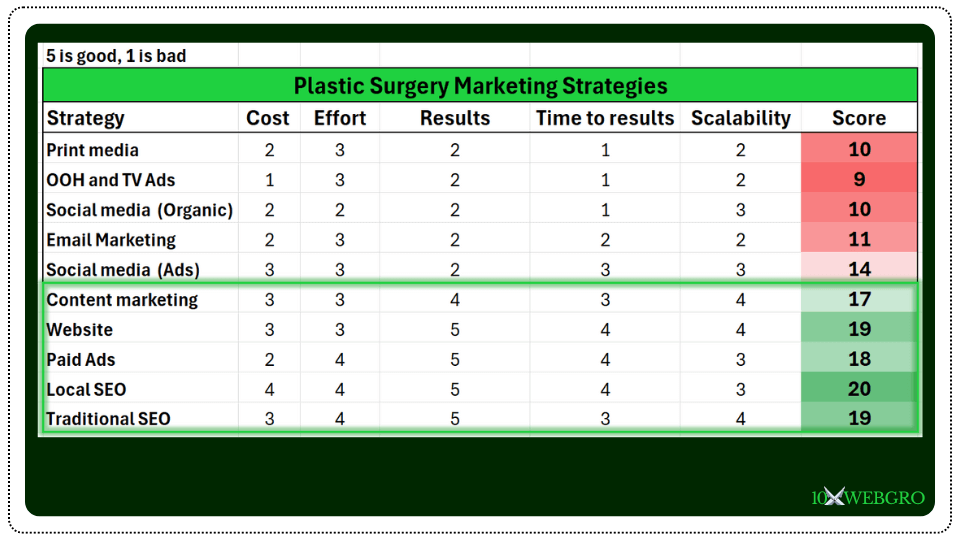
For one, it takes up a ton of time and energy (which you’re already limited by). And two, it doesn’t guarantee you’ll reach a niche audience who’s currently looking for plastic or cosmetic surgery.
So here’s what to do instead.
Dive deeper: THIS Is The BEST Strategy To Generate Leads For Plastic Surgery Centers In 2024
SEO traffic is plentiful and converts the highest
Organic traffic is a gift that keeps on giving. Organic traffic builds over time, unlike ads that require you to spend money to get traffic. You need to invest more in ads to get more traffic and leads.
The cost of patient acquisition from ads is huge and stops you to grow your ROI.
SEO continuously grow organic traffic, thanks to many keywords that we can target to keep building organic traffic. Eventually you’ll gain the infamous hockey stick growth

Organic traffic helps you generate more surgery leads and patients to increase your return on investment.
Its worth noting that nearly 80% of calls in plastic surgery sector originate from organic search.
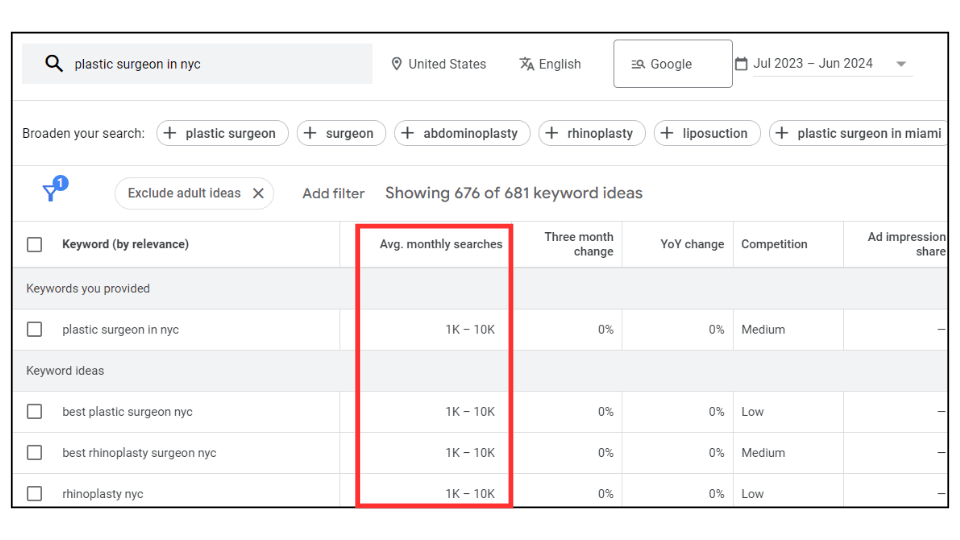
We helped a plastic surgery center gained almost 15k organic traffic using SEO.
Not bad, considering it’s all free traffic.
And this isn’t a one-time thing—we see the same with all of our clients.
Our simple 4-part SEO strategy for Plastic Surgery Centers
At 10X WEBGRO, we believe in keeping things simple.
We live by the Pareto Principle: focus on the 20% of work that will produce 80% of the results. This approach is especially true for SEO strategies.
By zeroing in on what truly matters and doing it exceptionally well, we can achieve outstanding results.
Here’s what you should focus on for maximum impact.
1. Optimize Your Local Google Business Profile
If you want more patients to find your plastic surgery practice, optimizing your Google Business Profile is a must. This boosts your visibility in local search results, making it easier for people in your area to discover your services.
Local search happens when someone uses geographic terms like a city or neighborhood in their search.
For example, if someone types “plastic surgeon in New York City,” it triggers the Google Maps Pack, showing a list of plastic surgeons in New York City next to a map.
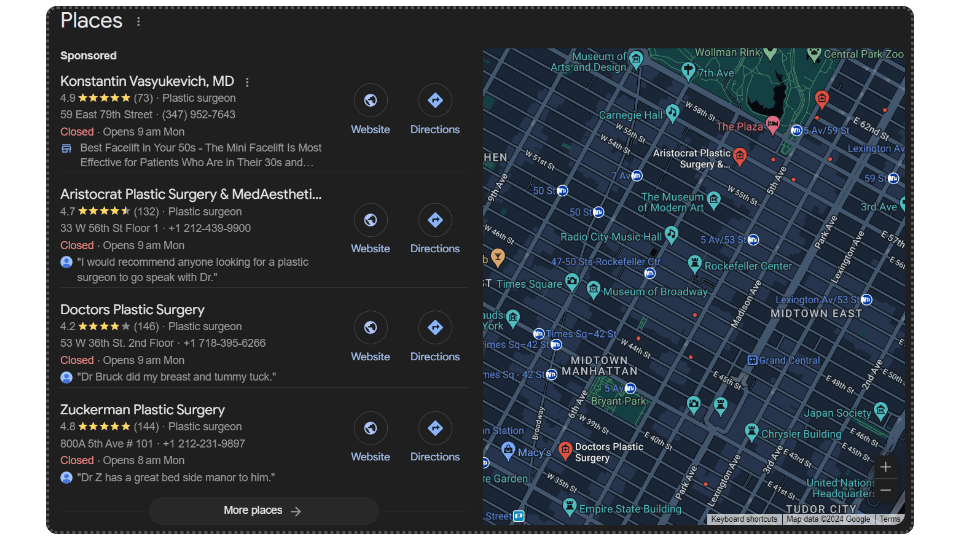
This Maps Pack is gold. It includes your website link, business hours, phone number, and directions—everything a potential patient needs to find and contact you. To rank in the top three, you need a verified physical location and a business profile optimized for local search.
Here’s how to optimize your profile:
- Verify Your Physical Address: Google will mail you a postcard with a code to confirm your location.
- Get Positive Reviews: Ask your patients to leave positive reviews on Google and other review sites.
- Choose Relevant Categories: Make sure you tag your business with the right categories.
- Keep Your Listing Updated: Regularly update your images, contact info, business hours, and any other details.
- Claim or Create Business Citations: Get your practice listed in local business directories like Yelp, Bing Places, and Yellow Pages.
By doing these things, you’ll signal to Google that your practice is active and relevant, which helps boost your ranking in local searches and the Maps Pack.
This way, more people in your area will find your practice when they need plastic surgery services.
2. Clean Up Your Website’s Structure
A messy website structure can confuse Google search bots, making it hard for them to crawl, index, and rank your pages properly. Getting your site structure right from the start is key to boosting your position in search engine results pages (SERPs).
How do you optimize your site structure? It’s about organizing your site with the right pages:
- Home Page
- Services
- About Us
- Contact
- Results
- Testimonials
- Before/after gallery
- Blog
Additional helpful pages include:
- FAQ
- Different Language Version of All Pages
For example, popular websites often have a clear structure. Take a look at MOON Plastic Surgery Center site.
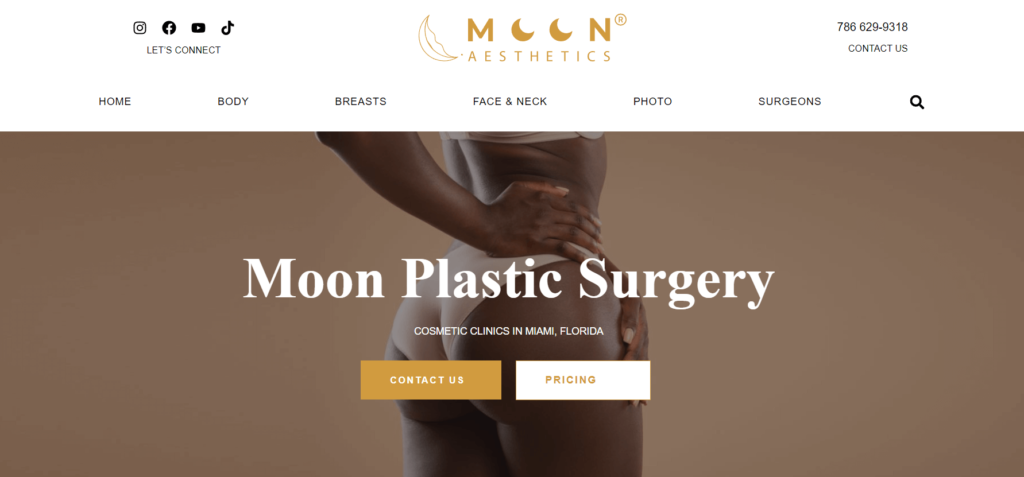
At the top, you can see their well-organized site structure, which includes all the essential pages and more.
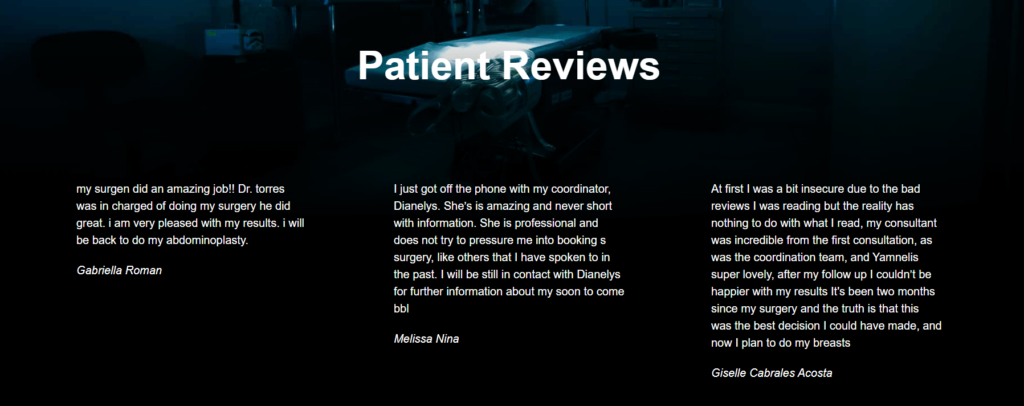
Having a Results or Testimonials page is crucial. It shows potential patients your success stories, which can help them decide to contact you.
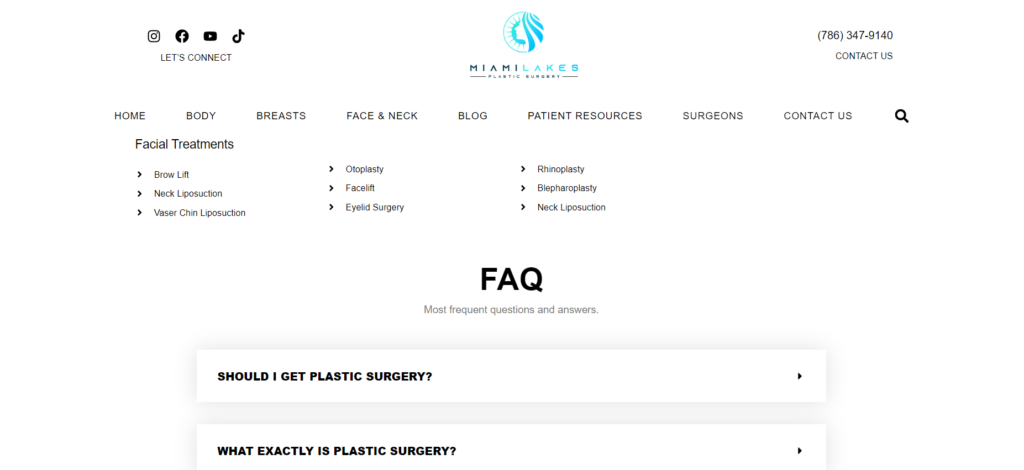
An FAQ page is also valuable. It addresses common questions patients may have, reducing their need to call your center and improving their overall experience on your site. Plus, it’s great for SEO because it captures keywords that can boost your rankings.
If you’re in an area with a significant non-English-speaking population, consider creating a Spanish version (or other relevant languages) of your site. This makes your services accessible to more people and boosts your SEO on Spanish Google. You can hire a freelance translator or use a translation tool and have an editor refine the content.
By organizing your website effectively, you make it easier for Google to understand and rank your pages, leading to better visibility and more patients for your plastic surgery practice.
3. Create Content That Informs and Educates
Creating content is like building roads that lead traffic to your website. Quality content ranks well and attracts people searching on Google.
For plastic surgery SEO, you need informative blog posts that educate your audience and guide them to conversions.
Your content should help visitors understand surgery needs and journey and how your practice can assist them.
Many visitors to your site will be in the research phase. They’re looking for information and aren’t ready to book a consultation yet. This is why publishing consistent, valuable content is crucial.
Aim to post at least one blog per week. For example, at 10X WEBGRO, we create 20 pages of content and schedule them to publish weekly, ensuring a steady flow of fresh, relevant material.
Publishing regularly tells Google that your site is active and valuable. This can even earn you backlinks from other sites that find your content useful, further boosting your SEO for plastic surgeons.
Remember, this content isn’t direct marketing traffic. Readers won’t instantly become patients after reading a blog post. The goal is to spread your footprint and grow your online presence steadily.
This is where informational content comes in.
Question is, “What type of content should plastic surgeons write?”
There are three types of content plastic surgeons should create to build a funnel that guides visitors through the customer journey:
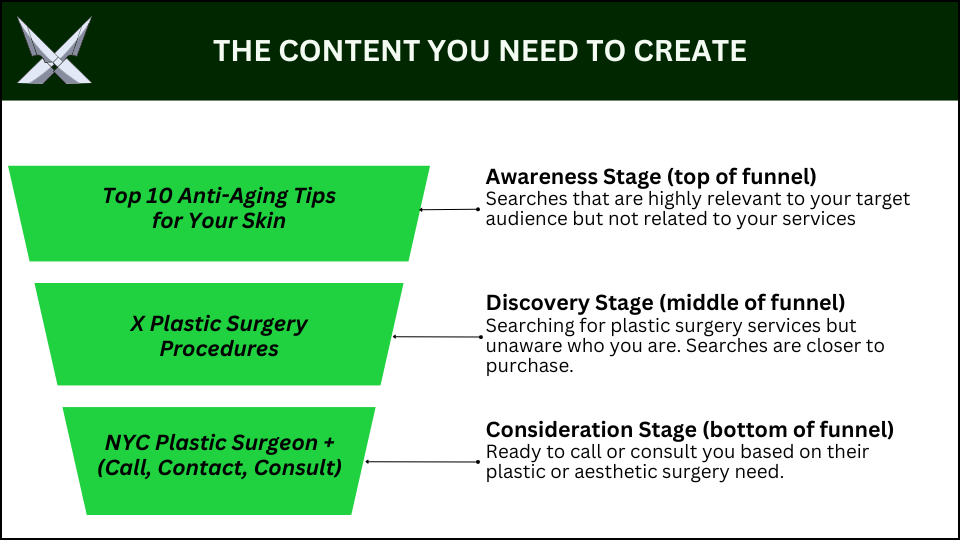
Creating a variety of content is essential to guide potential patients through their journey. By crafting specific content for each stage, you can move visitors closer to becoming your patients.
Top of the Funnel Content
At the top of the funnel, visitors aren’t necessarily looking for plastic surgery. They might be curious about related topics. For instance, they could be searching for information on “skin care tips after sun exposure.”
They’re not ready for a consultation yet, but by providing valuable content on these topics, you put your practice on their radar for future needs.
Middle of the Funnel Content
In the middle of the funnel, people are aware they might need a solution and are looking for options. This is where you create content that addresses their concerns more directly.
For example, posts like “Which Plastic Surgery Procedure is Right for You?” or “How to Choose the Right Plastic Surgeon” cater to their growing interest.
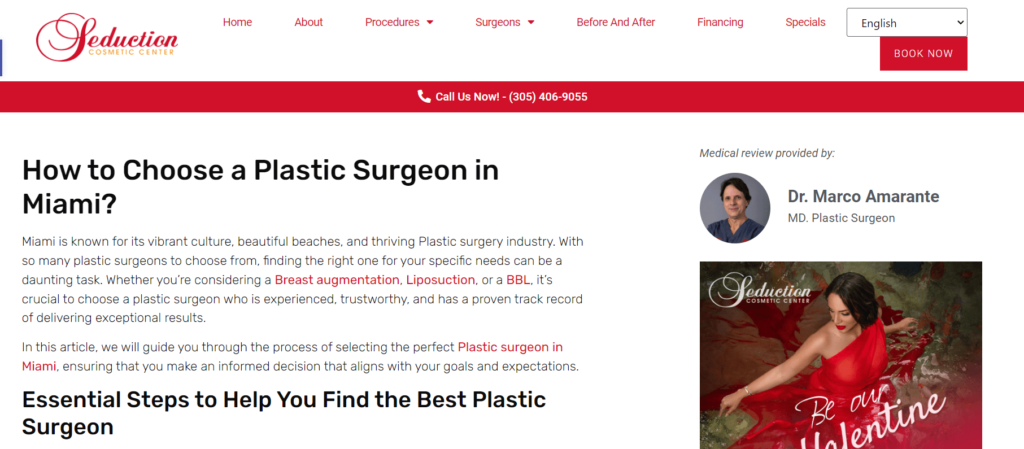
This stage is critical because these readers are closer to making a decision, and you want to ensure your content helps them trust your expertise.
At this stage, they’re looking to discover solutions to their problem. And since there are a lot more people in the middle who are a step away from a conversion, you want to focus 80% of your content here.
Bottom of the Funnel Content
At the bottom of the funnel, visitors are ready to take action. They’ve done their research and are looking for specific services.
Content here should include detailed procedure pages, patient testimonials, and clear calls to action like “Book a Consultation” or “Contact Us Today.”
For example, pages titled “Schedule Your Rhinoplasty Consultation” or “How Our Liposuction Transformed This Patient’s Life” ” are designed to convert interested visitors into actual patients.
Your website pages will contain keywords like “New York cosmetic surgeon,” or “best facial surgeon in Miami”. Localizing the keywords is necessary to target patients searching for plastic surgeon in a specific city.
Here’s how you might structure your content funnel for a plastic surgery center:
- Awareness Stage: Blog post titled “Top 10 Anti-Aging Tips for Your Skin” with a link at the end to a related post on non-surgical facial treatments.
- Discovery Stage: Post titled “Which Plastic Surgery Procedure is Right for You?” that links to a page detailing patient testimonials.
- Consideration Stage: Detailed case study “How Our Liposuction Transformed This Patient’s Life” with a direct link to your consultation booking page.
Each piece of content should have a call to action (CTA) that guides visitors to the next stage, ultimately leading them to book a consultation or contact your office.
By creating targeted content for each stage of the funnel, you can effectively guide potential patients through their journey, building trust and credibility along the way. This approach not only improves your SEO for plastic surgeons but also helps in converting visitors into patients.
In this example, MOON Plastic Surgery Center has a Brazilian Butt Lift page with a contact form for discount on the procedure and to book a consultation:
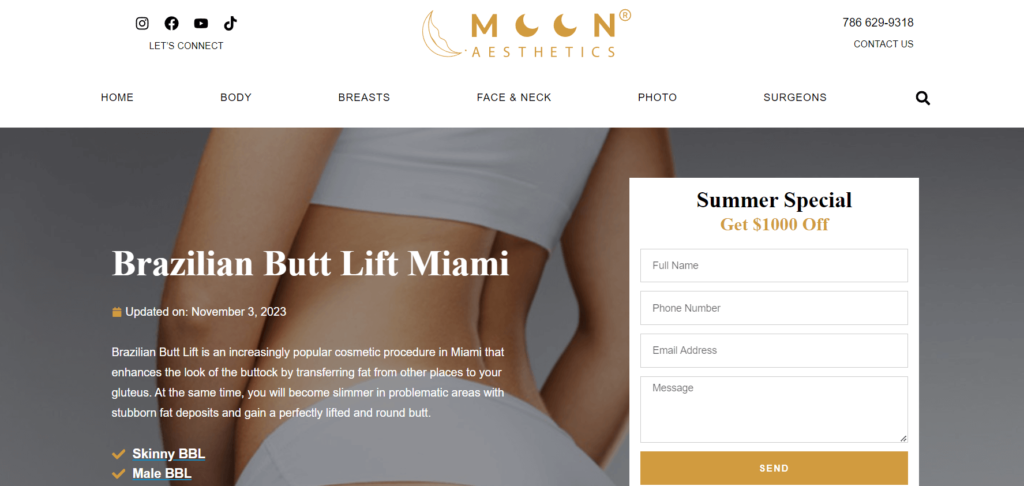
4. Building Backlinks for Your Plastic Surgery Practice
Having a well-structured website and great content is important, but building backlinks is what truly boosts your site’s authority in Google’s eyes. When credible sites link to your content, it’s like getting a thumbs up from a trusted source, which can significantly improve your ranking and bring more traffic to your site.
Backlinks are like votes of confidence from other websites. The more high-quality votes you have, the more Google will trust your site.
But not all votes are equal.
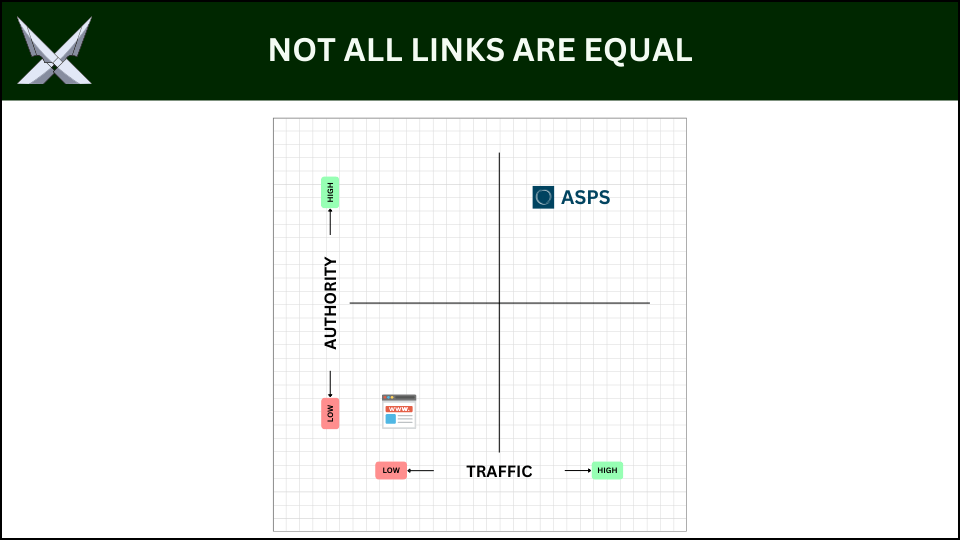
A link from a well-known, high-traffic site is much more valuable than one from a little-known blog.
Imagine your blog post on plastic surgery techniques being mentioned by a top health magazine. This tells Google that your site is credible and worth visiting. Plus, these backlinks drive traffic from those sites to yours, further proving your relevance.
Not all backlinks have the same impact. Links from high-authority sites (like major news outlets) are more valuable than those from low-traffic sites.
Here’s a breakdown of the types of backlinks building plastic surgeons should focus on:
- PR Links: These are links from news articles on popular sites like Forbes or Bloomberg. Public relations agencies can help you get featured in these outlets.
- HARO Links: “Help a Reporter Out” connects you with journalists looking for expert quotes. By contributing, you can get a backlink to your website.
- Niche-Specific Links: Links from other reputable plastic surgery or health-related websites. These can include guest posts, quotes, or mentions.
Using these types of backlinks helps establish your authority and improve your search rankings.
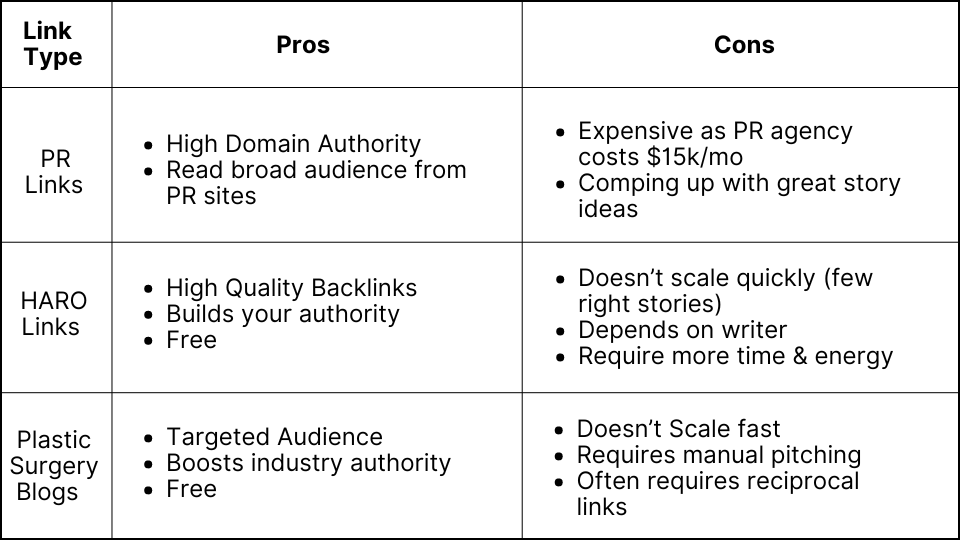
By focusing on these strategies, you can build a robust backlink profile that not only improves your site’s authority but also drives more traffic and potential patients to your practice.
SEO is awesome, but requires a lot of work—we can help
You’re a busy plastic surgeon with a packed schedule. While SEO is a powerful tool to help plastic surgery centers grow, it takes a lot of time and effort to do it right. That’s where we come in.
Partnering with a plastic surgery SEO agency means you get all the benefits of expert SEO strategies without the hassle. We understand the plastic surgery industry and know how to reach your audience effectively.
We start by analyzing your data from Google Analytics, checking out your top competitors, and looking at the total addressable market.
Then, we use growth models to predict the return on your investment with us.
When you work with us, you’ll have a clear idea of what to expect in terms of growth and results.
Interested in learning more? Contact our growth team today and find out how we can help your plastic surgery center thrive.